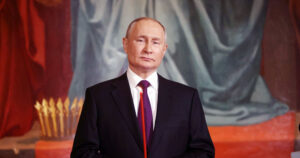On 13 September, Vladimir Putin issued a sobering threat. If Ukraine used Nato-supplied missiles against targets deep inside Russia, the president warned, the alliance would be “directly participating in the conflict” — and the US and its allies would be “fighting with Russia”. Putin’s comments echoed another threat, two years ago, when he drew several ”red lines” for Nato, adding that he was prepared to use nuclear weapons if they were crossed.
Here, then, we have the one of the least welcome developments of the 2020s: the return, after decades of absence, of the terrible spectre of nuclear war. And for those old enough to remember what it was like the first time round — or for their children who’ve watched the clips on YouTube — surely the most disturbing example of what atomic catastrophe might actually look like was first broadcast 40 years ago today. Shown by BBC Two on 23 September 1984, Threads is more horrifying and urgent than ever.
The scenario imagined in Threads is troublingly familiar. After an American-backed coup in a strategically important nation — in this case Iran — the Soviets invade. The US then moves to deploy troops. In unemployment-hit Sheffield, meanwhile, ordinary life goes on. A young couple prepares to become parents. The husband’s middle-aged father has been laid off; his redundancy money will go toward the renovation of the family’s home. Elsewhere, the local council is quietly making preparations in the event of war. Sheffield’s size, and the proximity of RAF Finningley, make the South Yorkshire town a prime target.
It is, by common consent, one of the darkest films ever made. There’s a disturbing sense of logical inevitability about the way the world moves step-by-step toward the precipice. The attack, when it comes, is unflinching, unsentimental and horrifyingly believable.
Writer Barry Hines — best-known for his novel A Kestrel for a Knave — sketches his native milieu with deft assurance. Hines, who died in 2016, was from the mining village of Hoyland, just outside Sheffield. In his career, he often focused on Northern England’s working class, and Threads is no different. As the Iran crisis escalates, for instance, we see protesters taking to the streets in a Campaign for Nuclear Disarmament march (most of the film’s actors were in fact CND members). Days later, there’s a moment of black humour when a speaker at a much more fraught protest calls for a general strike, as if that could have any effect whatsoever. It’s tempting to read the scene as a subtle comment on the eclipse of traditional Left politics in the age of Thatcherism.
Indeed, the whole film takes on added depth when viewed within that context: I think the film’s darkness has its roots not simply in the terrifying subject matter, but also in the broader political context of the Eighties. Labour had taken a radical turn under Michael Foot, with predictably dire consequences for the British Left. In 1983, after all, the Tories won a bumper majority, even as Labour slumped to their worst defeat since 1931. Success at the ballot box in turn ensured that the Thatcherite economic revolution would continue, and that resistance would largely be futile.
By 1984, the great dismantling of British social democracy was proceeding apace: businesses were privatised, unions were crushed, and social houses were being flogged to ex-tenants. Importantly for Hines, moreover, most of the pain was happening to northerners like him: by September 1986, 94% of the jobs that had been lost under Thatcherism were north of a line stretching from the Bristol Channel to the Wash.
For Leftists like Hines, Western defence policy doubtless explains Threads’ grim flavour too. Early in her premiership, Thatcher allowed the Americans to base nuclear-armed cruise missiles at RAF Greenham Common near Newbury, prompting protestors, almost exclusively women, to establish a “peace camp” at the base. The missiles were rightly seen as geopolitically destabilising since they could, in theory, be used to launch a surprise attack on Soviet targets like Moscow. That was echoed by instability elsewhere. The early Eighties saw a number of dangerous incidents — including the downing of a Korean Air passenger plane that had strayed into Soviet airspace, as well as provocative military exercises and false nuclear alarms — any one of which could easily have produced a crisis like that dramatised by Threads.
It hardly helped that, at the point the film came out, communication between East and West was minimal, with neither side having an accurate idea of what the other was thinking. In a June 1984 diary entry, for instance, Ronald Reagan recorded his shock at learning that Yuri Andropov, his by-then late Soviet counterpart, had genuinely suspected the president of plotting his own Operation Barbarossa: a pre-emptive nuclear strike on the USSR.
Economic upheaval at home and geopolitical tensions abroad, dovetailed with the ever-present threat of a mushroom-cloud disaster, all explain the movie’s distinctive style. And revisited today, Threads certainly manages to startle with its modernist aesthetic and bleak, eerie mood. It completely lacks the music that hamstrings so many modern docudramas. Hines, for his part, was even reluctant to include a narrator in his film, arguing that Paul Vaughan’s voiceover detracted from the drama. But Vaughan’s contribution works superbly. A familiar voice from BBC arts and science programmes, his terse descriptions of terrors like the impact of radiation lend authority to the film — by tying it to a familiar and cosy televisual world, Threads becomes all the more disquieting.
Yet more than its narrator, it’s surely the denouement of Threads that makes it so enduring. When, after ratcheting up the tension, we’re finally shown the actual bombing, it is genuinely frightening. There are no heroics, only suffering and death, either instantaneous or slow. Later, the nuclear exchange having run its course, a stark computer readout informs us that 3,000 megatons have been exploded globally, with 210 falling on Britain. Needless to say, the film’s second half isn’t easy to watch. Threads explores severals aspects of desperate postwar life: the hazards of radiation; the search for loved ones in the ruins; shortages of food and water; the collapse of law and order; the shooting of looters; the impossibility of treating the multitudes of sick and injured; the coming of nuclear winter. Just as powerful is the film’s final minutes, which shows the world years after the bombs have fallen. Almost everyone seems to be under eighteen, the clear implication being that no one lives very long anymore. Technology is at near-medieval levels.
This wretched narrative is hammered home by an utter lack of sentimentality. Threads has no heroes and major characters die abruptly. What viewers get instead are wordless montages, and blunt facts delivered in cyan text on a black screen. As in Brecht’s theatre, interpreting what is put before us in our usual clichéd, complacent way is made impossible.
Taken together, there’s even a sense in which the film strikes even at the religious convictions then loudly professed by many in the radical conservative movement that carried Reagan to the White House. Threads’ modernist vision of the universe is uncompromising: austere, matter-of-fact, devoid of metaphysical consolations. Even the Apocalypse, when it comes, appears to have no religious significance. The Rapture looked forward to by Evangelicals is nowhere to be seen. Life struggles on, but under massively worse conditions.
Docudramas as accomplished as Threads, so full of dark passion and righteous anger, are rare today. The gravity and urgency of the political situation in the mid-Eighties inspired a superb example of British cinematic modernism. The defenders of social democracy knew their world was disappearing, but faced an infinitely worse possibility: the destruction of the world, tout court. It’s clear this threat has in some way returned — thanks to Putin’s threats, but also events in the Middle East and Asia-Pacific — though I have my doubts whether our governing or creative classes fully grasp what that means.
Today there is a lack of vision. Perhaps the Cold War is distant enough that its lessons are being forgotten. Watch Threads and you’ll recall them soon enough.
Disclaimer
Some of the posts we share are controversial and we do not necessarily agree with them in the whole extend. Sometimes we agree with the content or part of it but we do not agree with the narration or language. Nevertheless we find them somehow interesting, valuable and/or informative or we share them, because we strongly believe in freedom of speech, free press and journalism. We strongly encourage you to have a critical approach to all the content, do your own research and analysis to build your own opinion.
We would be glad to have your feedback.
Source: UnHerd Read the original article here: https://unherd.com/




